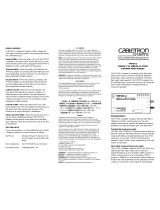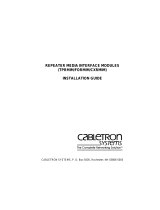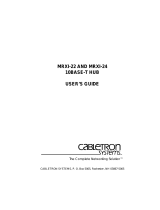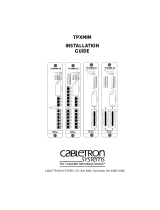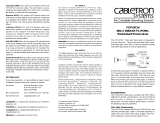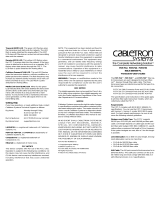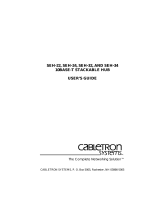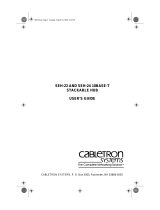Page is loading ...

USING LANVIEW
LANVIEW is Cabletron Systems’ diagnostic and
monitoring system.
Power (PWR)
When lit, this green LED indicates that
the COFOT is receiving power. If the PWR LED is not
lit, check that the power cord is plugged into the
COFOT and the wall socket, and that the wall socket
has power.
Transmit (XMT)
The green LED flashes when the CO-
FOT is receiving data at the fiber port and transmitting
it from the coax port. The LED flash is pulse stretched
for viewing effect.
Receive (RCV)
This yellow LED flashes when the CO-
FOT is receiving data at the coax port and transmitting
it from the fiber port. The LED is pulse stretched for
viewing effect.
Collision (CLN)
This red LED flashes when the
adapter detects a collision condition or a jabber packet
on the network. The flash frequency may increase as
network traffic increases since more collisions are
likely to occur. The LED is pulse stretched for viewing
effect.
Link OK (LNK)
When lit, this green LED indicates that
a link has been established between the COFOT and
the device at the other end of the fiber optic segment.
The LED remains lit as long as the link is maintained.
GETTING HELP
If you have questions, or need additional help, contact
Cabletron Systems Technical Support as follows:
By phone: Monday through Friday,
8 am to 8 pm EST at
(603) 332-9400
By CompuServe: GO CTRON from any ! prompt
By Internet mail: suppor[email protected]
LANVIEW
is a registered trademark,
COFOT-F1
and
COFOT-F2
are trademarks of Cabletron Systems, Inc.
CompuServe
is a registered trademark of CompuServe
Ethernet
is a trademark of Xerox Corp.
Velcro
is a registered trademark of Velcro Industries, B.V.
FCC NOTICE
This device complies with Part 15 of the FCC rules.
Operation is subject to the following two conditions: (1) this
device may not cause harmful interference, and (2) this
device must accept any interference received, including
interference that may cause undesired operation.
NOTE: This equipment has been tested and found to comply
with the limits for a Class A digital device, pursuant to Part 15
of the FCC rules. These limits are designed to provide
reasonable protection against harmful interference when the
equipment is operated in a commercial environment. This
equipment uses, generates, and can radiate radio frequency
energy and if not installed in accordance with the operator’s
manual, may cause harmful interference to radio
communications. Operation of this equipment in a residential
area is likely to cause interference in which case the user will
be required to correct the interference at his own expense.
WARNING:
Changes or modifications made to this device
which are not expressly approved by the party responsible for
compliance could void the user’s authority to operate the
equipment.
DOC NOTICE
This digital apparatus does not exceed the Class A limits for
radio noise emissions from digital apparatus set out in the
Radio Interference Regulations of the Canadian Department
of Communications.
NOTICE
Cabletron Systems reserves the right to make changes in
specifications and other information contained in this
document without prior notice. The reader should in all cases
consult Cabletron Systems to determine whether any such
changes have been made. The hardware, firmware, or
software described in this manual is subject to change
without notice.
IN NO EVENT SHALL CABLETRON SYSTEMS BE LIABLE
FOR ANY INCIDENTAL, INDIRECT, SPECIAL, OR
CONSEQUENTIAL DAMAGES WHATSOEVER
(INCLUDING, BUT NOT LIMITED TO, LOST PROFITS)
ARISING OUT OF OR RELATED TO THIS MANUAL OR
THE INFORMATION CONTAINED IN IT, EVEN IF
CABLETRON SYSTEMS HAS BEEN ADVISED OF, KNOWN
OR SHOULD HAVE KNOWN, THE POSSIBILITY OF SUCH
DAMAGES.
©Copyright September 1994 by
Cabletron Systems, Inc.
P.O. Box 5005, Rochester, NH 03866-5005
All Rights Reserved
Printed in The United States of America
Part number: 9030120-02 September 1994
COFOT-F1 and COFOT-F2
10BASE-2 to 10BASE-FL/FOIRL
Extended Media Adapter
The COFOT-F1 and COFOT-F2 coaxial to fiber optic
transceivers let you connect an Ethernet 10BASE-2
thin coaxial cable segment to a 10BASE-FL/FOIRL
fiber optic cable segment. The COFOT-F1 and
COFOT-F2 are identical except for their fiber optic
connectors:
• The COFOT-F1 has SMA connectors.
• The COFOT-F2 has ST connectors.
Except where noted otherwise, this guide collectively
refers to both versions of the adapter as COFOT.
REQUIREMENTS
The COFOT Extended Media Adapter complies with
IEEE 802.3 10BASE-FL/FOIRL specifications. You can
use the COFOT with Version 1, Version 2 or IEEE
802.3 equipment. For best network performance, be
sure to observe the following network guidelines.
Coax Requirements
Use 50
Ω
RG-58 coaxial cable. The cable must be
no
longer than 100 meters
. The cable must be
terminated with a 50
Ω
terminator at both ends. (The
COFOT has a switch selectable terminator.) The
COFOT supports a
maximum of ten connections
per segment.
COFOT
92 SERIES
10BASE-2
TO
10BASE-FL/FOIRL
MEDIA ADAPTER
WITH
LANVIEW
®
POWER
INPUT
The Complete Networking Solution
TERM
SN
LISTED
U
L
®
16EO
ITE REPEATER UNIT
THIS DEVICE COMPLIES WITH PART 15 OF THE FCC RULES.
OPERATION IS SUBJECT TO THE FOLLOWING TWO CONDITIONS:
(1) THIS DEVICE MAY NOT CAUSE INTERFERENCE, AND
(2) THIS DEVICE MUST ACCEPT ANY INTERFERENCE RECEIVED,
INCLUDING INTERFERENCE THAT MAY CAUSE UNDESIRED OPERATION.
POWER REQUIRED: 10-15V - - - , 800mA MAX
DATA CAPABILITY: 10Mb/s
®
TUV Rheinland
LR65407
RX
TX
P
W
R
X
M
T
R
C
V
C
L
N
L
N
K

Fiber Optic Requirements
The COFOT supports 50/125, 62.5/125, and 100/140
µ
m fiber optic cable. Link length depends on cable
type and system fiber optic budget. (The COFOT can
support a maximum link to link length of 1km.)
Fiber Optic Cable Link Attenuation
At an 850 nm wave length, link segment attenuation
can be no more than:
• 13.0 db for 50/125
µ
m cable
• 16.0 db for 62.5/125
µ
m cable
• 19.0 db for 100/145
µ
m cable
OPERATING SPECIFICATIONS
Cabletron Systems reserves the right to change these
specifications any time without notice.
Fiber Optic Interface
Receive Sensitivity: -29.5 dBm
Peak Input Power: -8.2 dBm
Bit Error Rate: Better than 10
-9
error rate
Transmitter Peak
Wavelength: 820 nm typical; 790 nm min;
860 nm max
Spectral Width: 75 nm max
Rise Time: 10 nsec max
Fall Time: 10 nsec max
Fiber Optic Transmitter Power
50/125
µ
m: -13.0 dBm
16.5 dBm worst case budget
62.5/125
µ
m -10.0 dBm
19.5 dBm worst case budget
100/140
µ
m: -7.0 dBm
22.5 dBm worst case budget
Note
: The transmitter power and receive sensitivity
levels are peak power levels. To convert to average
power levels, subtract 3 dBm.
BNC Interface
Termination: Can be connected to internal
50
Ω
terminator
Grounding: Connector is
NOT
grounded
System Characteristics
COFOT operational limits are determined by individual
system jitter. Because some Ethernet products built
before 1987 cannot operate when the jitter level
exceeds 14 ns, the COFOT may not give error free
operation in
all Ethernet environments.
Power Supply
Input Power USA: 90 - 135 Vac, 50-60 Hz
Input Power UK: 216 - 264 Vac, 50 Hz
Input Power Europe: 180 - 240 Vac, 50 Hz
Output Power: 0.8 amp at 12 Vdc
Note:
The power source for the COFOT is to be cer-
tified for use in the country of installation with a SELV
output of 12 Vdc, and capable of providing a minimum
output of 800 mA. the output connector is to be com-
patible with
TOTAL POWER or MORFUR RJ-01-E
connectors.
Operating Environment
Operating Range: +5
˚
to +40
˚
C (41
˚
to 104
˚
F)
Heat Output: 32.8 Btu/hr
Storage Range: -30
˚
to +80
˚
C (22
˚
to 160
˚
F)
Humidity Range: 5 to 95% (non-condensing)
Safety
Designed in accordance with UL1950 with D3 dev-
iations, NEC 725-2(b), CSA 22.2 No. 220, and EN
60950/DIN VDE 0805.
Emissions
Designed in accordance with EN 55022 Class A and
FCC Part 15 Class A emmission limits.
Note:
It is the responsibility of the person who sells
the system to which the COFOT will be a part to
ensure that the total system meets allowed limits of
conducted and radiated emissions.
INSTALLING THE COFOT
When you unpack the COFOT, verify that you receive
the following:
• One wall mount transformer with power cord
• One 1.5 inch x 3 inch Velcro® strip
• Three 6 inch tie wraps
• Three cable mounts
Mounting the COFOT
Remove the tape from the adhesive backed Velcro
strips. Place one Velcro half on the COFOT and the
other half on the mounting surface. Press on each
Velcro strip, then press the COFOT to the mounting
surface.
Connecting and Applying Power
The COFOT power cord has an AC to DC converter.
To connect the COFOT to a power source, plug the
converter into a standard wall outlet and the other end
of the power cord into the COFOT’s Power Input
connector. Once connected, the COFOT’s PWR
indicator should be illuminated, indicating that the
COFOT is receiving power and is ready for operation.
Caution:
Do not use a power cord/converter other
than the one that you received with the COFOT. Not all
converters supply the same voltage and current. Using
the wrong converter can damage the COFOT.
Attaching Fiber Optic Cables
Connect a fiber cable from the COFOT TX port to the
Ethernet device RX port, and from the COFOT RX
port to the Ethernet device TX port.
Caution:
If you are using SMA 906 connectors, use
half-alignment sleeves, not full alignment sleeves, on
the ends of the connectors. Full-alignment sleeves will
damage the COFOT’s SMA ports.
Attaching a Coax Cable
The COFOT has a selectable internal 50
Ω
terminator
which eliminates the need for a tee connector and
external terminator. To activate the COFOT’s internal
terminator, move the COFOT’s TERM switch to the ON
(
●
) position. If you use an external 50
Ω
termi-nator,
make sure that the internal terminator is turned off
(
❍
).
Warning:
When you set the TERM switch, use a non-
conductive probe or disconnect the power cord.
Warning:
The COFOT’s BNC port is not grounded.
Coax cable segments should be grounded at a single
point. For safety, only one end of any coax cable
segment should be connected to earth ground.
Cable Strain Relief
Anchor the data cables and the power cord to reduce
the possibility of network interruption. The COFOT
comes with adhesive backed mounting brackets and
tie wraps that you can use to anchor the COFOT’s
cables.
Cable Mounts and Tie Wraps
COFOT
92 SERIES
10BASE-2
TO
10BASE-FL/FOIRL
MEDIA ADAPTER
WITH
LANVIEW
®
POWER
INPUT
The Complete Networking Solution
TERM
SN
LISTED
U
L
®
16EO
ITE REPEATER UNIT
THIS DEVICE COMPLIES WITH PART 15 OF THE FCC RULES.
OPERATION IS SUBJECT TO THE FOLLOWING TWO CONDITIONS:
(1) THIS DEVICE MAY NOT CAUSE INTERFERENCE, AND
(2) THIS DEVICE MUST ACCEPT ANY INTERFERENCE RECEIVED,
INCLUDING INTERFERENCE THAT MAY CAUSE UNDESIRED OPERATION.
POWER REQUIRED: 10-15V - - - , 800mA MAX
DATA CAPABILITY: 10Mb/s
®
TUV Rheinland
LR65407
RX
TX
P
W
R
X
M
T
R
C
V
C
L
N
L
N
K
/
